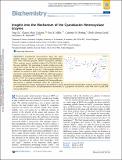Files in this item
Insights into the mechanism of the cyanobactin heterocyclase enzyme
Item metadata
| dc.contributor.author | Ge, Ying | |
| dc.contributor.author | Czekster, Clarissa Melo | |
| dc.contributor.author | Miller, Ona K. | |
| dc.contributor.author | Botting, Catherine H. | |
| dc.contributor.author | Schwarz-Linek, Ulrich | |
| dc.contributor.author | Naismith, James H. | |
| dc.date.accessioned | 2019-05-15T11:30:01Z | |
| dc.date.available | 2019-05-15T11:30:01Z | |
| dc.date.issued | 2019-04-23 | |
| dc.identifier | 258964229 | |
| dc.identifier | e9ece5d4-8cf4-4c77-ae75-208d653d6abb | |
| dc.identifier | 85064344519 | |
| dc.identifier | 000466053100007 | |
| dc.identifier | 30912640 | |
| dc.identifier.citation | Ge , Y , Czekster , C M , Miller , O K , Botting , C H , Schwarz-Linek , U & Naismith , J H 2019 , ' Insights into the mechanism of the cyanobactin heterocyclase enzyme ' , Biochemistry , vol. 58 , no. 16 , pp. 2125-2132 . https://doi.org/10.1021/acs.biochem.9b00084 | en |
| dc.identifier.issn | 0006-2960 | |
| dc.identifier.other | RIS: urn:E3FBC73937F5630330C8C7A3FB4421B2 | |
| dc.identifier.other | ORCID: /0000-0003-0526-223X/work/57568187 | |
| dc.identifier.other | ORCID: /0000-0002-7163-4057/work/59222330 | |
| dc.identifier.other | PubMedCentral: PMC6497369 | |
| dc.identifier.uri | https://hdl.handle.net/10023/17706 | |
| dc.description | The work is supported by the European Research Council NCB-TNT (339367), Biotechnology and Biological Sciences Research Council (BB/K015508/1 and BB/M001679/1). | en |
| dc.description.abstract | Cyanobactin heterocyclases share the same catalytic domain (YcaO) as heterocyclases/cyclodehydratases from other ribosomal peptide (RiPPs) biosynthetic pathways. These enzymes process multiple residues (Cys/Thr/Ser) within the same substrate. The processing of cysteine residues proceeds with a known order. We show the order of reaction for threonines is different and depends in part on a leader peptide within the substrate. In contrast to other YcaO domains, which have been reported to exclusively break down ATP into ADP and inorganic phosphate, cyanobactin heterocyclases have been observed to produce AMP and inorganic pyrophosphate during catalysis. We dissect the nucleotide profiles associated with heterocyclization and propose a unifying mechanism, where the γ-phosphate of ATP is transferred in a kinase mechanism to the substrate to yield a phosphorylated intermediate common to all YcaO domains. In cyanobactin heterocyclases, this phosphorylated intermediate, in a proportion of turnovers, reacts with ADP to yield AMP and pyrophosphate. | |
| dc.format.extent | 8 | |
| dc.format.extent | 1255062 | |
| dc.language.iso | eng | |
| dc.relation.ispartof | Biochemistry | en |
| dc.subject | QD Chemistry | en |
| dc.subject | DAS | en |
| dc.subject.lcc | QD | en |
| dc.title | Insights into the mechanism of the cyanobactin heterocyclase enzyme | en |
| dc.type | Journal article | en |
| dc.contributor.sponsor | BBSRC | en |
| dc.contributor.sponsor | BBSRC | en |
| dc.contributor.institution | University of St Andrews. School of Biology | en |
| dc.contributor.institution | University of St Andrews. Biomedical Sciences Research Complex | en |
| dc.contributor.institution | University of St Andrews. EaSTCHEM | en |
| dc.contributor.institution | University of St Andrews. School of Chemistry | en |
| dc.identifier.doi | 10.1021/acs.biochem.9b00084 | |
| dc.description.status | Peer reviewed | en |
| dc.identifier.grantnumber | BB/K015508/1 | en |
| dc.identifier.grantnumber | BB/M001679/1 | en |
This item appears in the following Collection(s)
Items in the St Andrews Research Repository are protected by copyright, with all rights reserved, unless otherwise indicated.

